The Response of Dung Beetle Communities to Land Use Change in the Brazilian Cerrado
Abstract
1. Introduction
- (i)
- The abundance, richness, biomass, and uniformity of beetle communities decrease with increasing land use intensity due to resource reduction and habitat degradation.
- (ii)
- The composition of the beetle community varies according to the type of land use, with forested areas serving as a reference. This pattern reflects the loss or replacement of species that are more sensitive to environmental changes.
- (iii)
- Local environmental and landscape changes influence the composition of the beetle community due to changes in habitat structure and resource availability.
- (iv)
- Different beetle species act as indicators for each land use system, as each system provides specific ecological conditions that favor different species.
2. Materials and Methods
2.1. Study Area and Dung Beetle Sampling
2.2. Sampling of Environmental Variables
2.3. Data Analysis
3. Results
4. Discussion
5. Conclusions
Author Contributions
Funding
Data Availability Statement
Acknowledgments
Conflicts of Interest
Abbreviations
| dbRDA | Distance-based redundancy analysis |
| distLM | Distance-based linear model |
| g | Gram |
| PCO | Ordering of main components |
| LUSs | Land use systems |
| v/v | Volume/volume |
| IV | Indicator Value |
References
- Kim, D.H.; Sexton, J.O.; Townshend, J.R. Accelerated deforestation in the humid tropics from the 1990s to the 2000s. Geophys. Res. Lett. 2015, 42, 3495–3501. [Google Scholar] [CrossRef] [PubMed]
- Silva, P.G.; Hernández, M.I.M. Spatial variation of dung beetle assemblages associated with forest structure in remnants of southern Brazilian Atlantic Forest. Rev. Bras. Entomol. 2016, 60, 73–81. [Google Scholar] [CrossRef]
- Pei, S.; Yu, P.; Raghwani, J.; Wang, Y.; Liu, Z.; Li, Y.; Tian, H. Anthropogenic land consolidation intensifies zoonotic host diversity loss and disease transmission in human habitats. Nat. Ecol. Evol. 2024, 9, 99–110. [Google Scholar] [CrossRef] [PubMed]
- Davies-Colley, R.J.; Payne, G.W.; Van-Elswijk, M. Microclimate Gradients Across a Forest Edge. N. Z. J. Ecol. 2000, 24, 111–121. Available online: https://www.jstor.org/stable/24054666 (accessed on 20 May 2020).
- Redding, T.E.; Hope, G.D.; Fortin, M.J.; Schmidt, M.G.; Bailey, W.G. Spatial patterns of soil temperature and moisture across subalpine forest-clearcut edges in the southern interior of British Columbia. Can. J. Soil Sci. 2003, 83, 121–130. [Google Scholar] [CrossRef]
- Haddad, N.M.; Brudvig, L.A.; Clobert, J.; Davies, K.F.; Gonzalez, A.; Holt, R.D.; Townshend, J.R. Habitat fragmentation and its lasting impact on Earth’s ecosystems. Sci. Adv. 2015, 1, e1500052. [Google Scholar] [CrossRef]
- Liu, J.; Maxwelll, M.; Hu, G.; Liu, J.; Wu, J.; Yu, M. How does habitat fragmentation affect the biodiversity and ecosystem functioning relationship? Landsc. Ecol. 2018, 33, 341–352. [Google Scholar] [CrossRef]
- Bitencourt, B.S. Forest Complexity Drives Dung Beetle Assemblages along an Edge-interior Gradient in the Southwest Amazon Rainforest. Ecol. Entomol. 2020, 45, 259–268. [Google Scholar] [CrossRef]
- Desrochers, A.; Fortin, M.J. Understanding Avian Responses to Forest Boundaries: A Case Study with Chickadee Winter Flocks. Oikos 2000, 91, 376–384. Available online: http://www.jstor.org/stable/3547558 (accessed on 20 May 2020). [CrossRef]
- Gardner, T.A.; Hernández, M.I.M.; Barlow, J.; Peres, C.A. Understanding the biodiversity consequences of habitat change: The value of secondary and plantation forests for neotropical dung beetles. J. Appl. Ecol. 2008, 45, 883–893. [Google Scholar] [CrossRef]
- Korasaki, V.; Lopes, J.; Brown, G.G.; Louzada, J. Using dung beetles to evaluate the effects of urbanization on Atlantic Forest biodiversity. Insect Sci. 2013, 20, 393–406. [Google Scholar] [CrossRef]
- Davis, A.L.V.; Scholtz, C.H. Dung beetle conservation biogeography in southern Africa: Current challenges and potential effects of climatic change. Biodivers. Conserv. 2020, 29, 667–693. [Google Scholar] [CrossRef]
- Klink, C.A.; Machado, R.B. Conservation of the brazilian Cerrado. Conserv. Biol. 2005, 19, 707–713. [Google Scholar] [CrossRef]
- MapBiomas. Coleção 9.0. Série Anual de Mapas de Cobertura e Uso da Terra do Brasil. 2025. Available online: https://brasil.mapbiomas.org/infograficos/ (accessed on 20 May 2020).
- Ab’saber, A.N. O Domínio dos Cerrados: Introdução ao Conhecimento. Fundação Cent. Formação Serv. Público 1983, 3, 41–55. [Google Scholar] [CrossRef]
- Myers, N.; Mittermeier, R.A.; Mittermeier, C.G.; Fonseca, G.; Kent, J. Biodiversity hotspots for conservation priorities. Nature 2000, 403, 853–858. [Google Scholar] [CrossRef] [PubMed]
- Overbeck, G.E.; Vélez-Martin, E.; Scarano, F.R.; Lewinsohn, T.M.; Fonseca, C.R.; Meyer, S.T.; Müller, S.C.; Ceotto, P.; Dadalt, L.; Durigan, G.; et al. Conservation in Brazil needs to include non-forest ecosystems. Divers. Distrib. 2015, 21, 1455–1460. [Google Scholar] [CrossRef]
- Correa, C.M.A.; Lara, M.A.; Puker, A. Cerrado vegetation conversion into exotic pastures negatively impacts flower chafer beetle assemblages in the west-central brazil. Int. J. Trop. Insect Sci. 2021, 41, 2459–2467. [Google Scholar] [CrossRef]
- Hernández, M.I.M.; Vaz-de-Mello, F.Z. Seasonal and spatial species richness variation of dung beetle (Coleoptera, Scarabaeidae s. str.) in the Atlantic Forest of southeastern Brazil. Rev. Bras. Entomol. 2009, 153, 607–613. [Google Scholar] [CrossRef]
- Gries, R.; Louzada, J.; Almeida, S.; Macedo, R.; Barlow, J. Evaluating the impacts and conservation value of exotic and native tree afforestation in Cerrado grasslands using dung beetles. Insect Conserv. Divers. 2011, 5, 175–185. [Google Scholar] [CrossRef]
- Filgueiras, B.; Tabarelli, M.; Leal, I.; Vaz-De-Mello, F.Z.; Iannuzzi, L. Dung beetle persistence in human-modified landscapes: Combining indicator species with anthropogenic land uses and fragmentation-related effects. Ecol. Indic. 2015, 55, 65–73. [Google Scholar] [CrossRef]
- Nichols, E.; Larsen, T.; Spector, S.; Davis, A.L.; Escobar, F.; Favila, M.; Vulinec, K. Global dung beetle response to tropical forest modification and fragmentation: A quantitative literature review and meta-analysis. Biol. Conserv. 2007, 137, 1–19. [Google Scholar] [CrossRef]
- Gómez-Cifuentes, A.; Munevar, A.; Gimenez, V.C.; Gatti, M.G.; Zurita, G.A. Influence of land use on the taxonomic and functional diversity of dung beetles (Coleoptera: Scarabaeinae) in the southern Atlantic Forest of Argentina. J. Insect Conserv. 2017, 21, 147–156. [Google Scholar] [CrossRef]
- Parmar, T.K.; Rawtani, D.; Agrawal, Y.K. Bioindicators: The natural indicator of environmental pollution. Front. Life Sci. 2016, 9, 110–118. [Google Scholar] [CrossRef]
- Nichols, E.; Spector, S.; Louzada, J.; Larsen, T.; Amezquitad, S.; Favila, M.E. Ecological functions and ecosystem services provided by Scarabaeinae dung beetles. Biol. Conserv. 2008, 141, 1461–1474. [Google Scholar] [CrossRef]
- Nichols, E.; Gardner, T.; Peres, C.A.; Spector, S. Co-declining mammals and dung beetles: An impending ecological cascade. Oikos 2009, 118, 481–487. [Google Scholar] [CrossRef]
- Braga, R.F.; Korasaki, V.; Audino, L.D.; Louzada, J. Are dung beetles driving dung-fly abundance in traditional agricultural areas in the amazon? Ecosystems 2012, 15, 1173–1181. [Google Scholar] [CrossRef]
- Braga, R.F.; Korasaki, V.; Andresen, E.; Louzada, J. Dung Beetle Community and Functions along a Habitat-Disturbance Gradient in the Amazon: A Rapid Assessment of Ecological Functions Associated to Biodiversity. PLoS ONE 2013, 8, e57786. [Google Scholar] [CrossRef]
- Vaz-de-Mello, F.Z. Estado Actual de Conhecimento dos Scarabaeidae s. str. (Coleoptera: Scarabaeoidea) do Brasil; Proyecto Iberoamericano de Biogeografía y Entomología Sistemática: PRIBES 2000: Trabajos del 1er Taller Iberoamericano de Entomología Sistemática; Sociedad Entomológica Aragonesa: Zaragoza, Spain, 2000; pp. 183–195. ISBN 84-922495-1-X. [Google Scholar]
- Oliveira, Y.F.; Oliveira, C.M.; Frizzas, M.R. Changes in land use affect dung beetle communities but do not affect ecosystem services in the cerrado of central brazil. Ecol. Entomol. 2021, 46, 973–987. [Google Scholar] [CrossRef]
- Numa, C.; Verdú, J.R.; Rueda, C.; Galante, E. Comparing dung beetle species assemblages between protected areas and adjacent pasturelands in a mediterranean savanna landscape. Rangel. Ecol. Manag. 2012, 65, 137–143. [Google Scholar] [CrossRef]
- Marsh, C.J.; Louzada, J.; Beiroz, W.; Ewers, R.M. Optimizing Bait for Pitfall Trapping of Amazonian Dung Beetles (Coleoptera: Scarabaeinae). PLoS ONE 2013, 8, e73147. [Google Scholar] [CrossRef]
- IBGE–Brazilian Institute of Geography and Statistics. Cidades. Available online: https://www.ibge.gov.br/cidades-e-estados/mg/frutal.html (accessed on 20 May 2020).
- Alvares, C.A.; Stape, J.L.; Sentelhas, P.C.; Gonçalves, J.D.M.; Sparovek, G. Köppen’s climate classification map for brazil. Meteorol. Z. 2013, 22, 711–728. [Google Scholar] [CrossRef] [PubMed]
- Silva, J.L.; Silva, R.J.; Fernandes, I.M.; Sousa, W.O.; Vaz-De-Mello, F.Z. Species composition and community structure of dung beetles (Coleoptera: Scarabaeidae: Scarabaeinae) compared among savanna and forest formations in the southwestern Brazilian Cerrado. Zoologia 2020, 37, e58960. [Google Scholar] [CrossRef]
- Nobis, M. SideLook 1.1-Imaging Software for the Analysis of Vegetation Structure with True-Colour Photographs. 2005. Available online: https://cir.nii.ac.jp/crid/1572543025616660352 (accessed on 15 May 2020).
- Mitchell, K. Quantitative analysis by the point-centered quarter method. arXiv 2010, arXiv:1010.3303. [Google Scholar]
- Hijbeek, R.; Koedam, N.; Khan, M.N.I.; Kairo, J.G.; Schoukens, J.; Dahdouh-Guebas, F. An evaluation of plotless sampling using vegetation simulations and field data from a mangrove forest. PLoS ONE 2013, 8, e67201. [Google Scholar] [CrossRef]
- ESRI-Environmental Systems Research Institute. “Topographic”. Base Map Collection. 19 de Fevereiro de 2020. Available online: http://www.arcgis.com/home/ (accessed on 20 May 2020).
- R Core Team. R: A Language and Environment for Statistical Computing; R Foundation for Statistical Computing: Vienna, Austria, 2020; Available online: https://www.R-project.org/ (accessed on 8 June 2020).
- Anderson, M.J.; Ellingsen, K.; McArdle, B.H. Multivariate dispersion as a measure of beta diversity. Ecol. Lett. 2006, 9, 683–693. [Google Scholar] [CrossRef]
- Anderson, M.J. A new method for non-parametric multivariate analysis of variance. Austral Ecol. 2001, 26, 32–46. [Google Scholar] [CrossRef]
- Clarke, K.R.; Gorley, R.N. PRIMER v6: User Manual/Tutorial (Plymouth Routines in Multivariate Ecological Research); PRIMER-E: Plymouth, UK, 2006; Volume 1, p. 866. [Google Scholar]
- McCune, B.; Mefford, M.J. PC-ORD Multivariate Analysis of Ecological Data, Version 4; MjM Software Design: Gleneden Beach, OR, USA, 1999.
- Dufrêne, M.; Legendre, P. Species Assemblages and Indicator Species: The Need for a Flexible Asymmetrical Approach. Ecol. Monogr. 1977, 67, 345–366. [Google Scholar] [CrossRef]
- McGeoch, M.A.; Rensburg, B.J.V.; Botes, A. The verification and application of bioindicators: A case study of dung beetles in a savanna ecosystem. J. Appl. Ecol. 2002, 39, 661–672. [Google Scholar] [CrossRef]
- Verdú, J.R.; Numa, C.; Hernández-Cuba, O. The influence of landscape structure on ants and dung beetles diversity in a mediterranean savanna—Forest ecosystem. Ecol. Indic. 2011, 11, 831–839. [Google Scholar] [CrossRef]
- Legendre, P.; Anderson, M.J. Distance-based redundancy analysis: Testing multispecies responses in multifactorial ecological experiments. Ecol. Monogr. 1999, 69, 1–24. [Google Scholar] [CrossRef]
- Anderson, M.J.; Gorley, R.N.; Clarke, K.R. PERMANOVA+ for PRIMER: Guide to Software and Statistical Methods; PRIMER-E Ltd., Plymouth Marine Laboratory: Plymouth, UK, 2008; p. 214. [Google Scholar]
- Chao, A.; Jost, L. Coverage-based rarefaction and extrapolation: Standardizing samples by completeness rather than size. Ecology 2012, 93, 2533–2547. [Google Scholar] [CrossRef]
- Sánchez-de-Jesús, H.A.; Arroyo-Rodríguez, V.; Andresen, E.; Escobar, F. Forest loss and matrix composition are the major drivers shaping dung beetle assemblages in a fragmented rainforest. Landsc. Ecol. 2015, 31, 843–854. [Google Scholar] [CrossRef]
- Hernández, M.I.M.; Barreto, P.S.C.S.; Costa, V.H.; Creão-Duarte, A.J.; Favila, M.E. Response of a dung beetle assemblage along a reforestation gradient in restinga forest. J. Insect Conserv. 2014, 18, 539–546. [Google Scholar] [CrossRef]
- Verdú, J.R.; Galante, E. Behavioural and morphological adaptations for a low-quality resource in semi-arid environments: Dung beetles (Coleoptera, Scarabaeoidea) associated with the european rabbit (Oryctolagus cuniculus L.). J. Nat. Hist. 2004, 38, 705–715. [Google Scholar] [CrossRef]
- Righi, C.A.; Sandoval-Rodríguez, C.; Ferreira, E.N.L.; Godoy, W.A.C.; Cognato, A.I. Microclimatic conditions for dung beetle (Coleoptera: Scarabaeidae) occurrence: Land use system as a determining factor. Environ. Entomol. 2018, 47, 1420–1430. [Google Scholar] [CrossRef] [PubMed]
- Costa, B.M.; Pantoja, D.L.; Sousa, H.C.; Queiroz, T.A.; Colli, G.R. Long-term, fire-induced changes in habitat structure and microclimate affect cerrado lizard communities. Biodivers. Conserv. 2019, 29, 1659–1681. [Google Scholar] [CrossRef]
- Almeida, S.S.P.; Louzada, J.; Sperber, C.F.; Barlow, J. Subtle land-use change and tropical biodiversity: Dung beetle communities in cerrado grasslands and exotic pastures. Biotropica 2011, 43, 704–710. [Google Scholar] [CrossRef]
- Farias, P.M.; Arellano, L.; Hernández, M.I.M.; Ortiz, S.L. Response of the copronecrophagous beetle (Coleoptera: Scarabaeinae) assemblage to a range of soil characteristics and livestock management in a tropical landscape. J. Insect Conserv. 2015, 19, 947–960. [Google Scholar] [CrossRef]
- Macedo, R.; Audino, L.D.; Korasaki, V.; Louzada, J. Conversion of cerrado savannas into exotic pastures: The relative importance of vegetation and food resources for dung beetle assemblages. Agric. Ecosyst. Environ. 2020, 288, 106709. [Google Scholar] [CrossRef]
- Martello, F.; Andriolli, F.S.; Souza, T.B.; Dodonov, P.; Ribeiro, M.C. Edge and land use effects on dung beetles (coleoptera: Scarabaeidae: Scarabaeinae) in brazilian cerrado vegetation. J. Insect Conserv. 2016, 20, 957–970. [Google Scholar] [CrossRef]
- Costa, C.M.Q.; Oliveira, V.H.F.; Maciel, R.; Beiroz, W.; Korasaki, V.; Louzada, J. Variegated tropical landscapes conserve diverse dung beetle communities. PeerJ 2017, 5, e3125. [Google Scholar] [CrossRef] [PubMed]
- Larsen, T.H.; Williams, N.M.; Kremen, C. Extinction order and altered community structure rapidly disrupt ecosystem functioning. Ecol. Lett. 2005, 8, 538–547. [Google Scholar] [CrossRef]
- Artuzo, F.D.; Foguesatto, C.R.; Souza, Â.R.L.; Silva, L.X. Costs management in maize and soybean production. Rev. Bus. Manag. 2018, 20, 273–294. [Google Scholar] [CrossRef]
- Aleixo, A. Effects of selective logging on a bird community in the brazilian atlantic forest. Condor 1999, 101, 537–548. [Google Scholar] [CrossRef]
- Reynolds, C.; Fletcher, R.J.; Carneiro, C.M.; Jennings, N.; Ke, A.; LaScaleia, M.C.; McCleery, R.A. Inconsistent effects of landscape heterogeneity and land-use on animal diversity in an agricultural mosaic: A multi-scale and multi-taxon investigation. Landsc. Ecol. 2018, 33, 241–255. [Google Scholar] [CrossRef]
- Nunes, R.V.; Vaz-de-Mello, F.Z. New brachypterous species of Dichotomius Hope, with taxonomic notes in the subgenus Luederwaldtinia Martínez (Coleoptera: Scarabaeidae: Scarabaeinae). Zootaxa 2013, 3609, 411–420. [Google Scholar] [CrossRef] [PubMed]
- Marchiori, C.H.; Caldas, E.R.; Almeida, K. Succession of scarabaeidae on bovine dung in Itumbiara, Goiás, Brazil. Neotrop. Entomol. 2003, 32, 173–176. [Google Scholar] [CrossRef]
- Rodrigues, S.R.; Barros, A.T.M.; Puker, A.; Taira, T.L. Diversidade de besouros coprófagos (coleoptera, scarabaeidae) coletados com armadilha de interceptação de voo no pantanal sul-mato-grossense, brasil. Biota Neotrop. 2010, 10, 123–127. [Google Scholar] [CrossRef]
- Tissiani, A.S.O.; Vaz-de-Mello, F.Z.; Campelo-Junior, J.H. Dung beetles of brazilian pastures and key to genera identification (coleoptera: Scarabaeidae). Pesqui. Agropecuária Bras. 2017, 52, 401–418. [Google Scholar] [CrossRef]
- Merritt, R.; Anderson, J. The effects of different pasture and rangeland ecosystems on the annual dynamics of insects in cattle droppings. Hilgardia 1977, 45, 31–70. [Google Scholar] [CrossRef]
- Correa, C.M.A.; Peres, N.D.; Holdbrook, R. Patterns of alimentary resource use by dung beetles in introduced brazilian pastures: Cattle versus sheep dung. Entomol. Sci. 2020, 23, 271–279. [Google Scholar] [CrossRef]
- Barretto, J.W.; Cultid-Medina, C.A.; Escobar, F. Annual abundance and population structure of two dung beetle species in a human-modified landscape. Insects 2018, 10, 2. [Google Scholar] [CrossRef]
- Pompeo, P.N.; Oliveira-Filho, L.C.I.; Klauberg-Filho, O.; Mafra, A.L.; Baretta, C.R.D.M.; Baretta, D. Diversidade de Coleoptera (Arthropoda: Insecta) e atributos edáficos em sistemas de uso do solo no Planalto Catarinense. Sci. Agrar. Parana. 2016, 17, 16–28. [Google Scholar] [CrossRef]
- Bogoni, J.A.; Hernández, M.I.M. Attractiveness of native mammal’s feces of different trophic guilds to dung beetles (coleoptera: Scarabaeinae). J. Insect Sci. 2014, 14, 299. [Google Scholar] [CrossRef] [PubMed]
- Tixier, T.; Bloor, J.; Lumaret, J. Species-specific effects of dung beetle abundance on dung removal and leaf litter decomposition. Acta Oecologica 2015, 69, 31–34. [Google Scholar] [CrossRef]
- Louzada, J.N.C.; Silva, P.R. Utilisation of introduced Brazilian pastures ecosystems by native dung beetles: Diversity patterns and resource use. Insect Conserv. Divers. 2009, 2, 45–52. [Google Scholar] [CrossRef]
- Diekmann, M. Species indicator values as an important tool in applied plant ecology—A review. Basic Appl. Ecol. 2003, 4, 493–506. [Google Scholar] [CrossRef]
- de Mattos, J.S.; Galetti, M.; Johnson, C.N.; Marquis, R.J.; Olesen, J.M.; Munk, M.; Owen-Smith, N. Ecological and evolutionary legacy of megafauna extinctions. Biol. Rev. 2018, 93, 845–862. [Google Scholar] [CrossRef]
- González-Tokman, D.; Cultid-Medina, C.; Díaz, A.S.; Escobar, F.; Ocampo-Palacio, L.; Martínez-Garza, C. Success or failure: The role of ecological restoration on the recovery of dung beetle diversity and function in a tropical rainforest. Rev. Mex. Biodivers. 2018, 89, 232–242. [Google Scholar] [CrossRef]
- Carvalho, R.L.; Andresen, E.; Arroyo-Rodríguez, V.; Anjos, D.V.; Resende, A.F.; Vaz de Mello, F.; Vasconcelos, H.L. Biodiversity in landscape mosaics: The roles of local land use and the surrounding landscape on dung beetle assemblages. J. Appl. Ecol. 2023, 60, 1647–1658. [Google Scholar] [CrossRef]
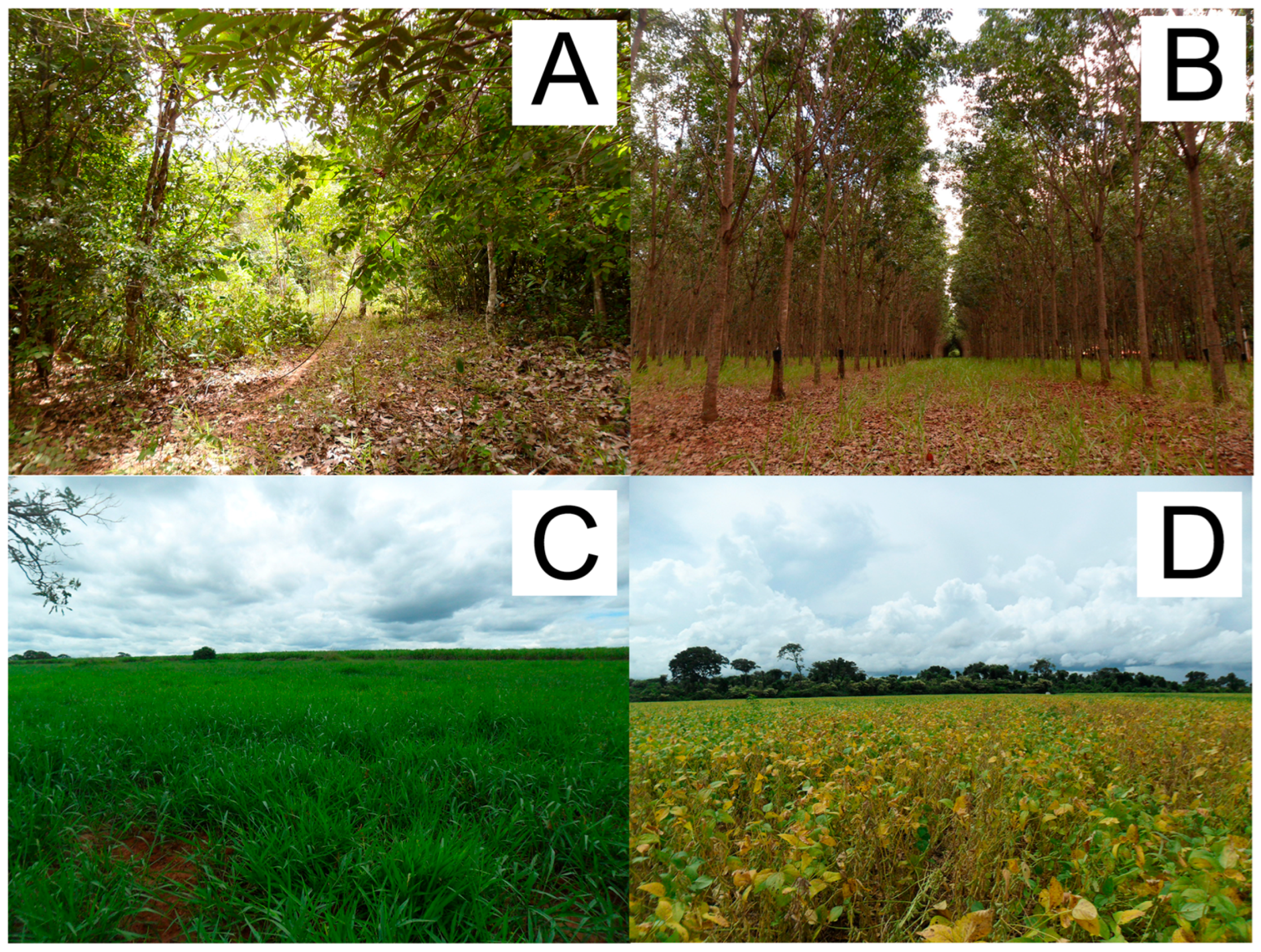

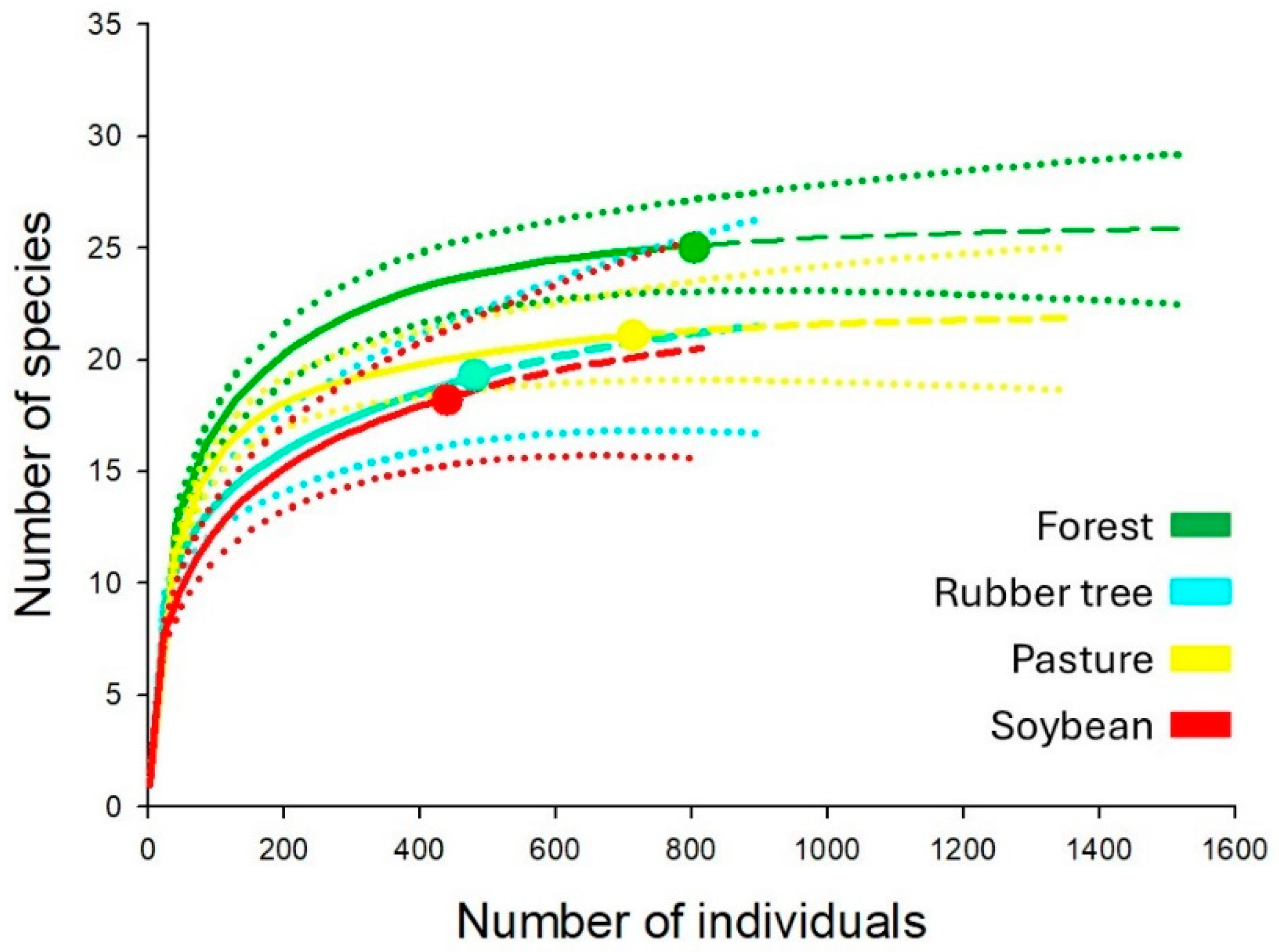
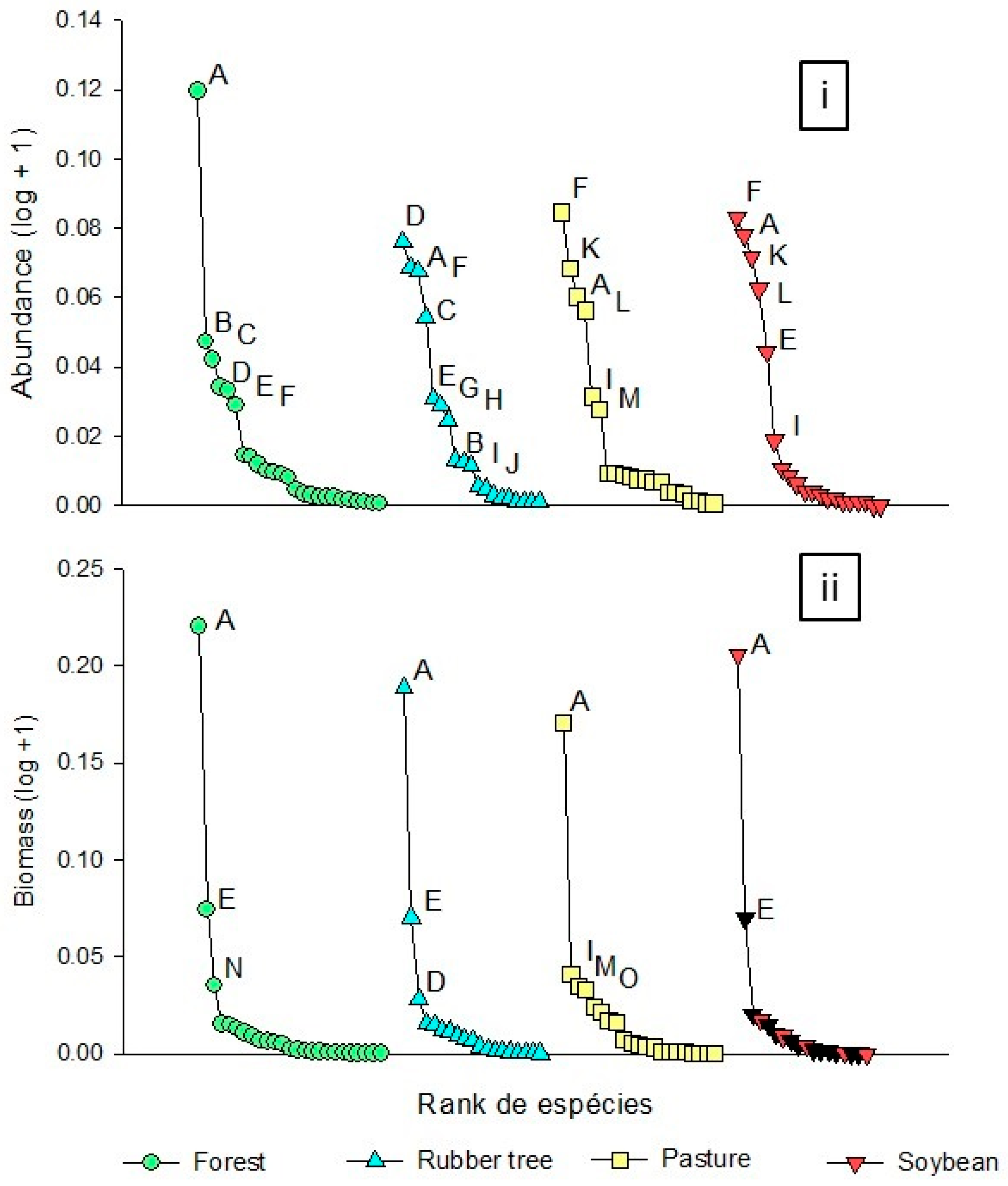
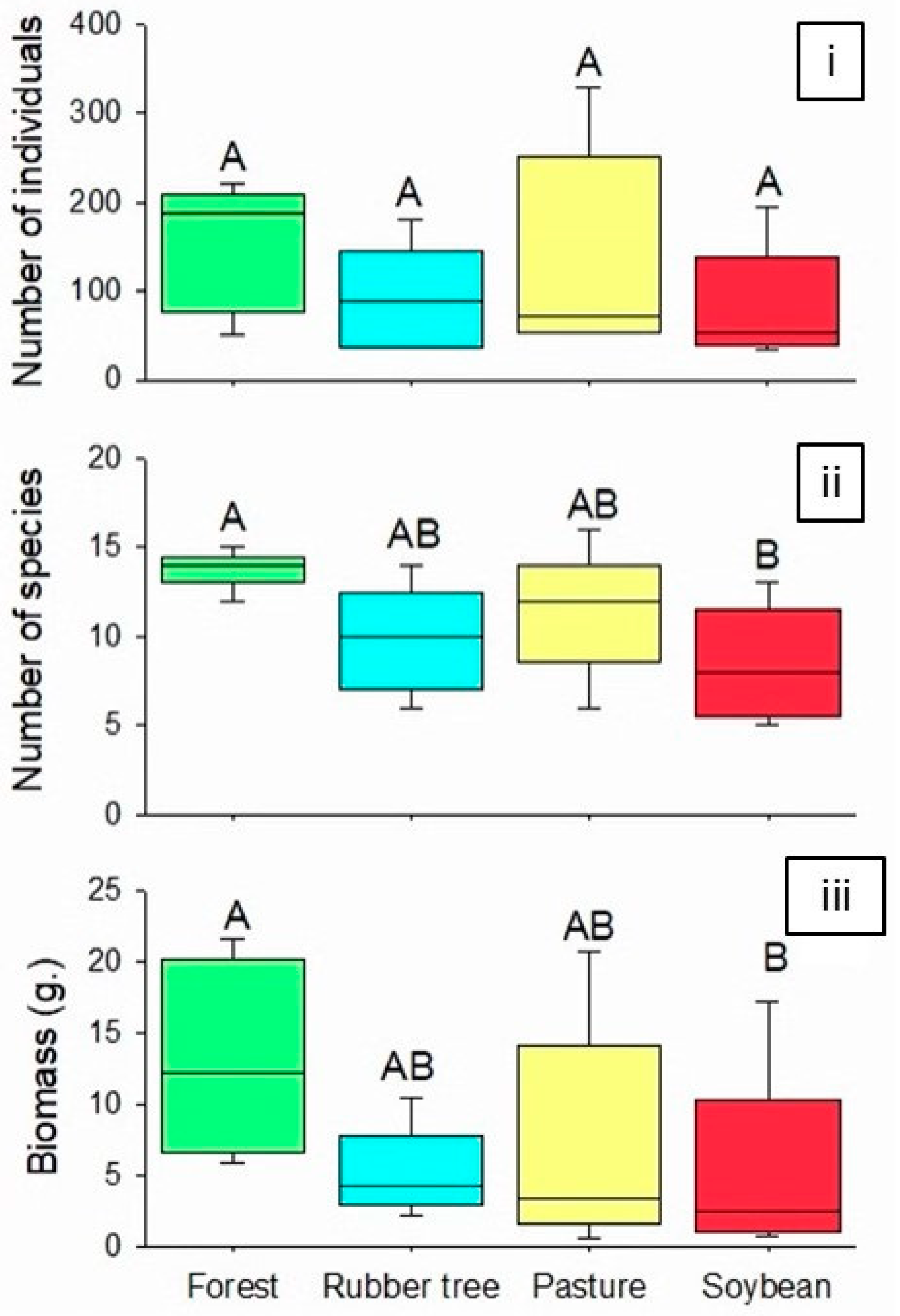

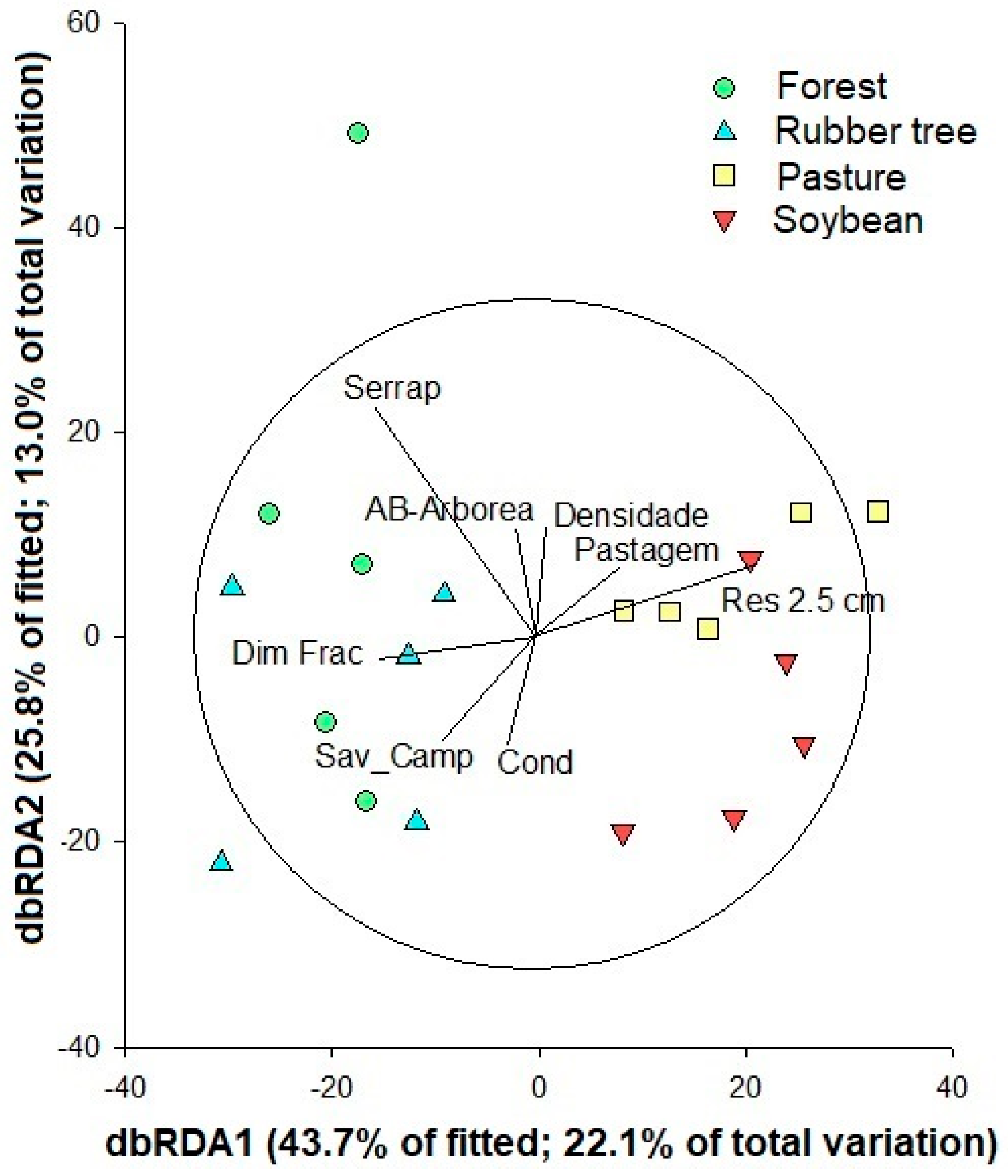
| Land Use | Characterization |
|---|---|
| Forest (A) | Areas with a predominance of tree species cover, with no history of cutting and felling. |
| Rubber tree (B) | Plantations of Hevea brasiliensis L. (rubber tree), the main management carried out consists of the following: land clearing and straw maintenance to control the growth of the herbaceous stratum and the understory. |
| Pasture (C) | Consisting of areas intended for livestock production, formed by exotic pastures, with a predominance of Urochloa spp. (Syn. Brachiaria spp.). |
| Soybean (D) | Consisting of conventional soybean monocultures (Glycine max (L.) Merr.). |
| Tribe/Species | System | Total | |||
|---|---|---|---|---|---|
| Forest | Pasture | Rubber Tree | Soybean | ||
| Ateuchini | |||||
| Agamopus viridis (Boucomont, 1928) | - | 15 | - | - | 15 |
| Genieridium bidens (Balthasar, 1938) | - | 101 | 1 | 73 | 184 |
| Ateuchus sp. 1 | - | 2 | - | 1 | 3 |
| Coprini | |||||
| Canthidium refulgens (Boucomont, 1928) | 62 | 15 | 86 | 8 | 171 |
| Canthidium sp. 1 | 3 | - | 3 | - | 6 |
| Canthidium sp. 2 | 1 | - | 3 | - | 4 |
| Canthidium sp. 3 | 6 | 11 | 26 | - | 43 |
| Canthidium sp. 4 | 2 | - | 1 | - | 3 |
| Canthidium sp. 5 | 14 | - | 5 | 63 | 82 |
| Dichotomius bos (Blanchard, 1843) | 2 | 6 | - | 4 | 12 |
| Dichotomius aff. carbonarius (Mannerhein, 1829) | 60 | - | 33 | 44 | 137 |
| Dichotomius glaucus (Harold, 1869) | 8 | - | - | - | 8 |
| Dichotomius nisus (Oliver, 1789) | 240 | 116 | 77 | 80 | 513 |
| Isocopris inhatus (German, 1824) | - | - | 1 | 1 | 2 |
| Ontherus appendiculatus (Mannerheim, 1829) | 16 | - | 31 | - | 47 |
| Ontherus sp. 1 | 26 | 11 | 13 | 18 | 68 |
| Ontherus sp. 2 | 18 | 12 | 6 | 10 | 46 |
| Ontherus sp. 3 | 21 | - | 12 | - | 33 |
| Deltochilini | |||||
| Anomiopus sp. 1 | 3 | - | - | - | 3 |
| Canthon conformis (Harold, 1868) | 77 | - | 60 | 6 | 77 |
| Canthon lituratus (Germar, 1824) | 4 | - | - | 4 | 8 |
| Canthon ornatus (Redtennbacher, 1868) | - | 6 | - | - | 6 |
| Deltochilum aff. guyanense (Paulian, 1938) | 1 | - | - | 1 | |
| Pseudocanthon sp. 1 | 4 | 14 | - | - | 28 |
| Onthophagini | |||||
| Onthophagus buculus (Mannerheim, 1829) | 25 | 13 | - | 3 | 41 |
| Onthophagus hircus (Billberg, 1815) | 87 | - | - | 87 | |
| Onthophagus ptox (Erichson, 1847) | - | - | 14 | 1 | 15 |
| Phanaeini | |||||
| Coprophanaeus cyanescens (d’Olsoufieff, 1924) | 17 | - | 2 | - | 19 |
| Coprophanaeus spitzi (Pessôa, 1935) | 4 | 5 | 1 | 1 | 11 |
| Dendropaemon nitidicollis (d’Olsoufieff, 1924) | - | 1 | - | - | 1 |
| Diabroctis mimas (Linnaeus, 1758) | - | 1 | - | 1 | |
| Gromphas inermis (Harold, 1869) | - | - | - | 2 | 2 |
| Phanaeus palaeno (Blanchard and Brullé, 1845) | 5 | 12 | - | - | 17 |
| Trichillum externepunctatum (Borre, 1886) | 52 | 146 | 76 | 86 | 360 |
| Number of Species | 25 | 17 | 19 | 17 | 34 |
| Number of Individuals | 758 | 679 | 751 | 406 | 2101 |
| GROUP | PERMANOVA | PERMDISP | ||
|---|---|---|---|---|
| T | p (Perm.) | T | p (Perm.) | |
| Soybean X Forest | 1.761 | 0.007 | 0.29698 | 0.888 |
| Soybean X Pasture | 1.0752 | 0.344 | 0.6901 | 0.6 |
| Soybean vs. Rubber Tree | 1.8527 | 0.011 | 1.094 | 0.282 |
| Forest vs. Pasture | 1.9018 | 0.011 | 0.70553 | 0.616 |
| Forest X Rubber Tree | 0.90103 | 0.628 | 0.84589 | 0.619 |
| Pasture X Rubber Tree | 2.34 | 0.005 | 0.02549 | 0.984 |
| Marginal Tests | ||||||
| Variables | SS (Traço) | Pseudo-F | p | Prop. | ||
| Fractal dimension | 2767.5 | 1.6478 | 0.106 | 0.083866 | ||
| Understory density | 2440.8 | 1.4377 | 0.174 | 0.073964 | ||
| Litter | 5337.2 | 3.473 | 0.001 | 0.16174 | ||
| Arboreal Density | 4160.5 | 2.5968 | 0.01 | 0.12608 | ||
| Tree basal area | 3777.3 | 2.3267 | 0.024 | 0.11447 | ||
| Soil condutivity | 1946 | 1.128 | 0.335 | 0.05897 | ||
| Soil penetration resistance 2.5 cm | 3648.1 | 2.2373 | 0.033 | 0.11055 | ||
| Soil penetration resistance 30 cm | 1206.5 | 0.68308 | 0.728 | 0.036562 | ||
| Soil penetration resistance 60 cm | 1903 | 1.1016 | 0.359 | 0.057668 | ||
| Forest formations | 1632.5 | 0.93683 | 0.522 | 0.049471 | ||
| Savanna formations | 1527.7 | 0.87373 | 0.585 | 0.046294 | ||
| Pasture | 2836.8 | 1.6929 | 0.099 | 0.085964 | ||
| Others | 1363.5 | 0.77581 | 0.614 | 0.041319 | ||
| Sequential Test | ||||||
| Variables | Adj R2 | SS (traço) | Pseudo-F | p | Prop. | Cumul. |
| +Litter | 0.11517 | 5337.2 | 3.473 | 0.001 | 0.16174 | 0.16174 |
| +R_2.5 | 0.16474 | 3000.5 | 2.0683 | 0.048 | 0.090926 | 0.25266 |
| +Frac Dim | 0.22865 | 3226.5 | 2.4084 | 0.018 | 0.097775 | 0.35044 |
| +Pasture | 0.27414 | 2524.9 | 2.0028 | 0.037 | 0.076512 | 0.42695 |
| +Conduct_mv | 0.27797 | 1354 | 1.0797 | 0.366 | 0.041031 | 0.46798 |
| +Tree Basal Area | 0.28259 | 1358.3 | 1.0901 | 0.359 | 0.041162 | 0.50914 |
| +Tree Density | 0.29517 | 1508.2 | 1.232 | 0.335 | 0.045704 | 0.55485 |
| +Savanna Formation | 0.30434 | 1399.2 | 1.1581 | 0.351 | 0.042101 | 0.59725 |
Disclaimer/Publisher’s Note: The statements, opinions and data contained in all publications are solely those of the individual author(s) and contributor(s) and not of MDPI and/or the editor(s). MDPI and/or the editor(s) disclaim responsibility for any injury to people or property resulting from any ideas, methods, instructions or products referred to in the content. |
© 2025 by the authors. Licensee MDPI, Basel, Switzerland. This article is an open access article distributed under the terms and conditions of the Creative Commons Attribution (CC BY) license (https://creativecommons.org/licenses/by/4.0/).
Share and Cite
Peixoto, P.G.; Barbosa, G.d.S.; Martins, H.L.; Franco, A.L.; Mata, J.F.d.; Korasaki, V. The Response of Dung Beetle Communities to Land Use Change in the Brazilian Cerrado. Land 2025, 14, 781. https://doi.org/10.3390/land14040781
Peixoto PG, Barbosa GdS, Martins HL, Franco AL, Mata JFd, Korasaki V. The Response of Dung Beetle Communities to Land Use Change in the Brazilian Cerrado. Land. 2025; 14(4):781. https://doi.org/10.3390/land14040781
Chicago/Turabian StylePeixoto, Pedro Gomes, Gabriela de Sousa Barbosa, Heytor Lemos Martins, Ana Luíza Franco, Jhansley Ferreira da Mata, and Vanesca Korasaki. 2025. "The Response of Dung Beetle Communities to Land Use Change in the Brazilian Cerrado" Land 14, no. 4: 781. https://doi.org/10.3390/land14040781
APA StylePeixoto, P. G., Barbosa, G. d. S., Martins, H. L., Franco, A. L., Mata, J. F. d., & Korasaki, V. (2025). The Response of Dung Beetle Communities to Land Use Change in the Brazilian Cerrado. Land, 14(4), 781. https://doi.org/10.3390/land14040781








